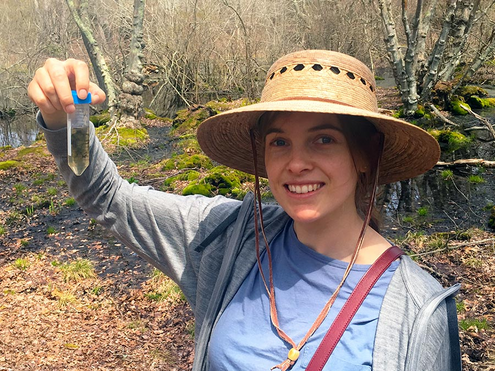Pondlife
Our Tiny Neighbors

Sally collects samples from a pond.
Hi, my name is Sally Warring. I am a microbiologist at the American Museum of Natural History. I study microbes, organisms that are too small to be seen without a microscope. They live in the air, soil, and water all around us. Some even live in our own bodies!
In these videos, I’ll introduce you to our tiny neighbors. And we’ll explore how these microscopic organisms act as architects, builders, travelers, parasites, hunters, scavengers, and prey.
EPISODE 1
Pond Scum Under the Microscope
Pond Scum Under the Microscope – PONDLIFE, Episode 1
[ELECTRONIC MUSIC]
[American Museum of Natural History logo animates on and off over footage of pond grasses fluttering in the wind.]
[Animation of hand dipping a sample cup into water.]
[Animation of a pipette putting a drop of water onto the slide of a portable microscope.]
[ELECTRONIC MUSIC AND SOUND OF WATER DROPLET]
[Animated view through a microscope’s eyepiece. The title “PONDLIFE” resolves into view, surrounded by microscopic organisms.]
[MICROSCOPE SLIDE CLICKS INTO PLACE]
[Dr. Sally Warring walks down the front steps of the American Museum of Natural History.]
[BOUNCY, ELECTRONIC MUSIC]
[Scenes of Warring walking down New York City streets segue into views of Central Park nature.]
SALLY WARRING (microbiologist): My name is Sally. I am a biologist at the American Museum of Natural History where I study microscopic organisms.
[Warring draws a sample from the Harlem Meer—a pond in Central Park—and other water bodies. New Yorkers and tourists enjoy the Park around her.]
WARRING: On Pondlife we are going to go on a safari to explore the microbial wildernesses that exist all around us.
[Views of Central Park’s Harlem Meer—a manmade pond, surrounded by trees, with buildings towering in the distance.]
WARRING: I’m in the middle of Manhattan.
[Warring speaks to camera, standing next to the Harlem Meer.]
WARRING: I’m at the Harlem Meer in Central Park and I’m here to look for a particular microbial community.
[Pond scum floats on the surface of the Harlem Meer.]
WARRING: It’s a community that you might have seen before, but you’ve probably not looked at it quite like this.
[Grasses and reeds grow on the edges of the Meer. Ducks paddle in the water.]
WARRING: For most of human history, people thought of all life as being plants and animals.
[Warring speaks to camera.]
WARRING: And the fact that species existed that were so small that you couldn’t even see them…
[Close-up of pond scum floating on the surface of the Meer.]
WARRING: …was completely unknown.
[Warring speaks to camera.]
WARRING: That all changed in the Seventeenth Century when a Dutch fabric designer…
[Portrait of a man with shoulder-length curly wig and neck scarf. Text labels him as “Antonie van Leeuwenhoek.”]
WARRING: …named Antonie van Leeuwenhoek invented the most powerful microscope the world had ever seen.
[Warring speaks to camera and pulls a small microscope out of her back pocket.]
WARRING: I have a replica of his microscope in my pocket. This is it.
[Close-up of a small piece of metal with various attachments, mounted on a rod.]
WARRING: This tiny little thing contains a really small spherical glass lens…
[Warring speaks to camera, holding the mini-microscope.]
WARRING: …and that spherical glass lens was capable of magnifying up to 300 times.
So, he would place he was interested in on one side of the lens. He would look through by placing the microscope right up to his eye.
[Warring holds the mini-microscope up to her eye. She then speaks to camera.]
WARRING: So, using this microscope he became the first person to see unicellular life, and he first saw that unicellular life when he looked at a community of microorganisms called pond scum.
[Close up of lumpy pond scum, floating on the surface of the Meer. Warring speaks to camera.]
WARRING: And I can see a beautiful example right over here.
[BUBBLY ELECTRONIC MUSIC]
[Warring walks over to side of the Meer and kneels down next to the water.]
WARRING: This is great…
[Using a stick, Warring pulls out a stringy, slimy mass of material from the floating pond scum.]
WARRING: This is exactly what we’re looking for.
Beautiful pond scum.
[Warring puts the pond scum into a sample jar. She holds the jar up for the camera.]
WARRING: Success!
[Warring sits on a park bench, holding the Leeuwenhoeck replica microscope.]
WARRING: That pond scum is a growth of filamentous green algae and I’ve put some here on my Leeuwenhoeck microscope…
[Extreme close-up of a strand of algae mounted on the mini-microscope.]
WARRING: …and we’re going to take a look and see what he might have seen in the pond for the first time.
[Warring speaks to camera from the park bench. She raises the Leeuwenhoeck microscope to her eye.]
[A view of dozens of green, thread-like strands resolve into focus, although the image is somewhat cloudy.]
WARRING: Leeuwenhoeck learned by looking through his microscope that the pond scum was made up of green algae that wound together.
[Small organisms move among the green strands.]
WARRING: But what amazed him the most was that moving amongst that green algae were tiny little creatures.
[Illustration of microorganisms in various forms—some resemble jellyfish or a broom.]
WARRING: He called those little creatures animalcules or “little animals.”
[Warring speaks to camera from the park bench. She holds a modern portable field microscope.]
WARRING: These days microscopy and our understanding of microbiology have come along way. I have with me a modern-day field microscope. Rather than a small spherical lens it has an objective.
[In close-up, Warring holds the field microscope. Off to the side is an animated diagram of the lens objective. It’s cylindrical in shape.]
WARRING: An objective contains many glass lenses stacked one on top of the other.
[The lens objective housing dissolves into an illustration of the stacked lenses, which then telescope apart to illustrate their various shapes and sizes. Some are thicker, some with more extreme convex sides, one somewhat mushroom-shaped.]
WARRING: We’re gonna take a look at what we’ve got.
[Warring places a glass slide on the field microscope, and with a pipette, drops on a sample from the Meer. She clamps the slide into place and then peers through the lens.]
WARRING: At one hundred times magnification we can really see the details of the green algae.
[The green algae appears as thick, rope-like strands under the microscope.]
WARRING: It’s called spirogyra.
[ELECTRONIC MUSIC]
WARRING: Each spirogyra filament is one cell thick, about the width of a human hair.
[In various views of the spirogyra, the strands have clear walls, inside of which are coiled, thinner filaments. This is clearly seen in an extreme close-up where the coil looks like a tight spring.]
WARRING: Spirogyra gets its name because inside each cell there is a long, thin, green chloroplast that coils and gives the organism its corkscrew appearance.
[An animated graphic indicates the green coil as a “chloroplast.”]
WARRING: Spirogyra, like all algae, live off sunlight.
[Strands of spirogyra slide slowly across the microscope’s field of view.]
WARRING: But when they grow in dense mats like the one in the Harlem Meer the filaments on top end up shading the ones beneath.
But Spirogyra has a way of dealing with this. The filaments are able to glide and stay constantly on the move. This way each filament will, at least for part of the time, have access to the sun.
[A small organism darts among the strands of spirogyra.]
WARRING: Just like Leeuwenhoek we find many microbial creatures living among the algae.
[A close-up of an elliptical microscopic organism. Animated text names it as a “ciliate.”]
WARRING: Here there are several species of ciliate.
[A different, circular-shaped ciliate is shown. Hundreds of tiny hair-like threads ring the ciliate and move swiftly, propelling the organism in a counterclockwise rotation.]
WARRING: Ciliates are a diverse group of single cellular organisms that are covered in small, hair-like structures called cilia.
[An animated graphic indicates the external hair-like structures and the text “cilia” appears.]
WARRING: Each species of ciliate has a unique arrangement of cilia.
[Small semi-circular organisms travel along the side of a spirogyra strand, as if they are moving up and down a road.]
WARRING: This one has cilia only on the underside of its cell. It uses the cilia like tiny legs to walk about on the spirogyra.
[FLUTTERING ELECTRONIC MUSIC]
[Bell-shaped organisms tremble at the end of long, slender stalks.]
WARRING: This is one of the ciliates that Leeuwenhoek was first to describe. It’s called Vorticella. Each is an individual bell-shaped cell sitting atop a long stalk.
[Close-up of the bell-shaped parts of several Vorticella. Wider view of several Vorticella near a few strands of spirogyra.]
WARRING: That stalk is rather special. It’s a curious coiling contraption that can move like lightning if the cell senses any danger.
[The Vorticella contract at a remarkable speed and then return to the full length of their stalks.]
[ELECTRONIC PULSES]
[Close-up of the bell-shaped part of one Vorticella.]
WARRING: The stalk also keeps the Vorticella anchored, so that it can use its cilia to generate a current in the water.
[Around the lip of the “bell,” numerous thin cilia move rapidly.]
WARRING: The cilia are arranged in a ring around an opening in the cell that acts as a mouth.
The cilia beat and drag water, bacteria, and other small microbes right into the Vorticella’s waiting mouth.
[A transparent circular organism with radiating spine-like structures sits among threads of spirogyra.]
WARRING: This beautiful organism is a heliozoan—“helio-“ meaning sun and “-zoan” meaning animal. Though, it’s not an animal at all.
[Close up of a heliozoan. A graphic points out the “spines,” and names them as “axopodia.”]
WARRING: The heliozoan is covered in many spike-like structures called axopodia, which radiate out from the cell’s surface and act as a net for ensnaring prey.
In real time the heliozoan appears static, but in time lapse it really comes to life.
[CYCLING ELECTRONIC MUSIC]
[The heliozoan moves among the spirogyra in sped-up footage, using its axopodia to propel it through the spirogyra. It engulfs a much smaller organism.]
WARRING: A green cell is ensnared…
[An animated graphic indicates the small organism trapped inside the heliozoan and text reads, “a catch!”]
WARRING: …but makes a lucky escape.
[The small organism escapes the clutches of the heliozoan. A second, greenish organism is now ensnared by the heliozoan.]
WARRING: The second cell is not so lucky.
[An animated graphic indicates the small green organism and text reads, “dinner!”]
[A leaf-shaped organism swims by, like a manta ray twisting in spirals. Text identifies it as a Phacus.]
WARRING: Leeuwenhoek was fascinated by organisms that moved like animals, but were green like plants.
This one is called Phacus. It’s not an animal, or a plant. It belongs to a completely separate group of organisms called the euglena. Its movement is due to long, thin structure called a flagellum that extends out the front of the cell.
[An animated graphic points out the flagellum waving rapidly back and forth at the “front” of the euglena.]
WARRING: The flagellum beats and pulls the cell through the water. You can also catch a glimpse of a red spot inside the Phacus. This is called an eyespot.
[Animated graphic indicates the red eyespot as the Phacus moves through the water.]
WARRING: It sits at the base of the flagellum and can detect the intensity and direction of light.
[The Phacus swims between the much larger strands of spirogyra.]
WARRING: Like a plant the Phacus lives off sunlight and this eyespot allows it to move through the water to wherever the light intensity is best.
[LILTING ELECTRONIC WALTZ]
[On the park bench, Warring removes the microscope from her eye and speaks to camera.]
WARRING: In that one drop of water we just saw a wide variety of microbial species. In the whole pond their numbers probably reach into the many thousands. And that’s only scratching the surface of the amount of microbial diversity that we could find the world over. And to really get a handle on this microbial diversity, we’re just going to have to keep exploring.
I’m gonna put these microbes back where I got ‘em from.
[Warring takes the sample jar back over to the Meer and puts its contents back in the water. She picks up her bag and walks off.]
[Text reads, “This series was made possible with a grant from Science Sandbox, an initiative of the Simons Foundation, and with the support of the Gordon and Betty Moore Foundation.”]
[Credits roll over various scenes of the Harlem Meer and its surroundings.]
EPISODE 2
Blue-green Algae from Pond to Lab
PONDLIFE – Episode 2 - Blue-green Algae from Pond to Lab
[ELECTRONIC MUSIC]
[American Museum of Natural History logo animates on and off over footage of ducks and turtles swimming in a greenish lake.]
[Animation of hand dipping a sample cup into water.]
[Animation of a pipette putting a drop of water onto the slide of a portable microscope.]
[ELECTRONIC MUSIC AND SOUND OF WATER DROPLET]
[Animated view through a microscope’s eyepiece. The title “PONDLIFE” resolves into view, surrounded by microscopic organisms.]
[MICROSCOPE SLIDE CLICKS INTO PLACE]
[Joggers and bicyclists move along roads in Central Park. New Yorkers and tourists enjoy the Park and the view of the city skyline.]
SALLY WARRING (microbiologist): We are surrounded by hidden microscopic worlds filled with fascinating life forms.
Thousands of microbial organisms live within a single drop of water.
[A fountain bubbles outside of the American Museum of Natural History’s 77th Street entrance, the name of the Museum is partially visible through a tree. Dr. Sally Warring walks out of this entrance towards the street.]
WARRING: On Pondlife, we’re going on a safari to explore the microbial wildernesses that exist all around us.
[Warring speaks to camera in Central Park.]
WARRING: Today I’m out looking for a group of organisms that evolved over two billion years ago.
These organisms were the first to live by photosynthesis.
[Looking towards the sky, sunlight is visible through the leaves and branches of trees. A bee crawls along small yellow flowers.]
WARRING: That’s the process of using sunlight to make sugars…
[Mandarin ducks swim on the surface of a pond.]
WARRING: …and then those sugars are used to power the cell.
[Turtles sunbathe on a rock in a pond.]
WARRING: …A byproduct of photosynthesis is oxygen…
[Warring speaks to camera.]
WARRING: …and two billion years ago these organisms became so abundant that they completely changed the Earth’s atmosphere.
It went from one that was very oxygen-poor…
[View of the New York City skyline from a bridge in the Park. Visitors on paddle boats move along The Lake.]
WARRING: …to the oxygen-rich atmosphere that we live in today.
[Warring speaks to camera.]
WARRING: These microbes are called cyanobacteria and lucky for me, they are just as abundant today as they were two billion years ago.
In fact, I haven’t had to go very far at all to find them.
[Warring walks along large rocks in the Park to a lake. ]
WARRING: I’ve simply walked out the door, I’ve crossed the road, and I can already see a pond that is teeming with cyanobacteria.
[Text identifies a greenish body of water as “The Lake, Central Park, New York City.”]
[Close-up footage of the surface of The Lake shows a slimy green film. Warring approaches the edge of The Lake and examines it.]
[BUBBLING ELECTRONIC MUSIC]
WARRING: You can find cyanobacteria all over the world.
There are currently around 3,000 described species with different morphologies and habitats from freshwater ponds to arctic oceans. They even live in soil.
[Warring climbs some large rocks near the edge of The Lake.]
WARRING: As I wander around Central Park, I’m on the lookout for signs of cyanobacteria.
[LILTLING ELECTRONIC MUSIC]
[Warring approaches a different edge of The Lake and fills a small glass container with water. She turns to the camera to speak.]
WARRING: It’s cyanobacteria that are making this pond so green.
If you look closely at this water sample…
[Closeup of water in container. It has a greenish hue and is cloudy with small particles.]
WARRING: …you can see that it’s full of tiny, floating, green particles.
Each one of those particles is a colony of cyanobacteria and each one of those colonies is made up of multiple individual cyanobacterial cells living together.
[Warring sits on a rock near the lake, sets down her water sample, and removes a field microscope from her bag.]
WARRING: To find out what species of cyanobacteria is living here I’m going to have to put it under the microscope.
[Warring prepares a glass slide with a drop of water from the sample, then raises the microscope to her eyes.]
[Under the microscope, groupings of small brownish-green dots float against a white background. Text identifies them as “Microcystis.”]
WARRING: The cyanobacterium blooming in the Lake belongs to the genus Microcystis. Microcystis colonies are made up of many individual cells suspended in a clear mucus.
[Closeup of a single colony of Microcystis, which is a clear, circular, gelatinous-looking shape with even smaller green circles within it, these are individual cells.]
WARRING: A colony may start as one cell…
[Closeup of a single greenish cell.]
WARRING: …which divides to become two cells…
[Now two cells are connected to one another.]
WARRING: …then four…
[Now there are four adjoining cells.]
WARRING: …and so on until some colonies are large enough to see with the naked eye.
[POPPING ELECTRONIC SOUNDS]
[Colonies of Microcystis float against a white background.]
WARRING: The colonies grow fast in warm summer waters, and when their numbers get dense enough, we call this a bloom.
[Microscopic view of many differently-shaped colonies of cyanobacterial species moving slowly.]
WARRING: Many cyanobacterial species are bloom-forming, and you can distinguish each species by their unique colony shapes.
One advantage of living as a colony is that when many individuals live together, tasks can be divided among the members.
We can see this in another cyanobacterium from the lake.
[A colony made of a strand of individual greenish-brown cells coiled into a spiral moves across the screen. A few cells within the strand are more circular shaped and lighter green than the others.]
WARRING: This one belongs to the genus Dolichospermum, and among its helical colony, some cells look a little different from the rest.
[Microscope focuses on these different, lighter green cells.]
WARRING: These specialized cells are called heterocysts and they have given up their photosynthetic ability to focus on the task of absorbing nitrogen.
They build that nitrogen into molecules that can be shared and used by all the cells in the colony, and in return the other cells share the sugars gain through photosynthesis with the heterocyst.
By dividing up these tasks, each is run more efficiently, and the colony can prosper.
[UPBEAT ELECTRONIC MUSIC]
[Back in Central Park, Warring packs up her field microscope and walks through the park to a different water’s edge. She uses a pipette to pick up some green algae from the water.]
WARRING: Thousands of visitors walk through Central Park every day, mostly unaware of the many tiny dramas playing out all around them.
[Warring prepares a microscope slide with the sample she has collected.]
WARRING: With a microscope, we can catch a glimpse into these unseen worlds.
[Warring lifts the microscope to her eye.]
WARRING: The bloom in the next pond is dominated by a cyanobacterium from the genus Aphanizomenon.
[Under the microscope, several long strands of green-brown cyanobacteria colonies drift slowly.]
WARRING: Aphanizomenon forms long, thin, filamentous colonies.
And while at first they appear to only drift, under time-lapse we can see just how busy they are.
[With time sped up, the colonies move more quickly. Some small organisms move amongst the colonies.]
[RUSTLING ELECTRONIC SOUNDS]
WARRING: There is a good reason to stay on the move.
Cyanobacteria sit at the base of the food chain and are good eating for a number of small predators.
This ciliate is a specialist cyanobacteria predator.
[The microscope focuses on a small circular ciliate, green-brown in color with a clear membrane around it.]
WARRING: It’s from the genus Nassula and it’s using its sensitive cilia to feel out a filament, searching for an end.
[The ciliate feels its way along one of the long thin cyanobacteria colonies.]
WARRING: Once located, it begins its work, sucking in the cyanobacteria like a strand of spaghetti.
[WHIRRING ELECTRONIC SOUND]
[The ciliate finds the end of the filament and begins consuming the cyanobacteria, coiling the long strand inside its body as it does.]
WARRING: As the cyanobacteria get ingested the filament bends and breaks, allowing it to fit inside the rotund little ciliate.
[Closeup of the ciliate ingesting cyanobacteria.]
[WHIRRING, SLURPING ELECTRONIC SOUNDS]
WARRING: This process can take a little time, especially if the filament is particularly long.
[A series of short clips show the ciliate ingesting more and more of the filament.]
WARRING: The ciliate keeps going… and going…and going…and going…and going, until the cyanobacteria are completely swallowed up.
[The ciliate ingests the last of the filament.]
WARRING: Delicious.
[BUBBLY ELECTRONIC MUSIC]
[Back in Central Park, the blue sky shows through the tops of trees. The city skyline outside the park is visible from a bridge. Ducks swim on a pond. Warring walks into frame against greenery, holding a water sample, and speaks to camera.]
WARRING: When I’m out looking at these microbial communities, I often see things that I want to take a closer look at and there’s only so much I can do out in the field with my portable microscope. So, when I see something interesting, I take a sample and that comes with me back to the museum and into the lab.
[Warring puts the sample into her bag and walks out of frame.]
[BUBBLY ELECTRONIC MUSIC]
[Warring enters a laboratory. Text in the lower left reads: “American Museum of Natural History, New York City”. She puts the water sample down on a lab table.]
WARRING: While I’m working with the pond water, I want to keep everything sterile.
[Now wearing black latex gloves, Warring sprays both gloved hands with sterilizing liquid from a bottle and rubs them together. She then sprays and wipes a glass lab jar.]
WARRING: This is because I don’t want microbes that might be growing in the lab or on me to end up growing in my lab cultures.
[Warring brings two now-sterilized glass jars and some other materials over to her workspace, a biosafety cabinet.]
WARRING: Now that the microbes are out of the pond and in the lab, I also need to make sure they have everything they need to survive.
[Warring uses a large pipette to fill small culture dishes with liquid from the two glass jars.]
WARRING: The bottles here contain different types of growth media. Each medium contains vitamins, minerals, and salts that microbes need.
[Warring sits in front of the biosafety cabinet, a metal table enclosed in metal on three sides and glass on the fourth. The glass can be raised and lowered to allow access to the table. The cabinet has a ventilation hood on top.]
WARRING: This big thing is a biosafety cabinet and it’s going to help me keep everything sterile.
I wiped everything down with ethanol before it went into the cabinet, but it also has this wall of air that passes from this vent at the bottom right up the front…
[Warring indicates a vent that runs along the edge of the table underneath the glass plate, blowing air over a person’s hand as they reach into the cabinet.]
WARRING: …and that prevents any microbial spores that might be in the air from traveling though into this cabinet.
At the same time, the cabinet is constantly sucking air up through a vent in the top…
[Warring places her hand inside the cabinet and indicates the vent that is sucking air above the cabinet.]
WARRING: …and that means that if any microbial spores do make it through into the cabinet, they get sucked up into that vent rather than landing on my cultures.
I add a small amount of pond water to liquid medium or spread some out onto an agar plate.
[Warring adds a few drop of the pond water sample to the small culture dishes filled with liquid growth medium, and a few drops to a wide Petrie dish filled with a gelatinous substance.]
WARRING: That agar plate contains growth medium too, but it’s been solidified by the addition of agar—a kind of jelly-like substance that’s produced by certain seaweeds.
[Warring uses a metal instrument to evenly distribute the pond water along the surface of the agar plate.]
WARRING: Some microbes prefer to grow on the solid surface of the agar, while others grow better suspended in the liquid medium.
[Warring picks up the liquid cultures and the agar plate, places them inside a growth chamber that resembles a refrigerator, closes the door to the chamber, and speaks to camera.]
WARRING: I keep those cultures in a growth chamber, the growth chamber maintains the temperature and provides a constant amount of light each day.
[Back under the microscope, small microorganisms move around a helical (spiral-shaped) Dolichospermum colony.]
WARRING: Cyanobacterial blooms can cause real problems, some produce toxins that are lethal to many animals.
I’m interested in the microbes that thrive here, organisms like these flagellates…
[On-screen text identifies a small, bluish, tear-shaped organism as a “flagellate.”]
WARRING: …and this euglena algae…
[On-screen text identifies a circular, yellow-green organism as a “euglena.”]
WARRING: …or this collodictyon…
[On-screen text identifies a circular organism that is brown on the inside of a clear transparent membrane as a “collodictyon.”]
WARRING: …all living among the bloom.
[Bright green microorganisms move frenetically, some as individual cells and some in colonies.]
WARRING: Over the next few weeks some of these microbes will grow in numbers…
[Bright green colonies are now grouped together as they grow.]
WARRING: …until eventually I can isolate and identify individual species from those liquid cultures, and from the agar plate.
[Green cyanobacterial growth is now visible on the surface of the agar plate with the naked eye.]
[Warring takes off her black latex gloves and speaks to camera in front of lab equipment.]
WARRING: I’m hoping that by growing and studying some of these microbes that are present in the cyanobacterial blooms that we’ll learn more about the blooms as communities and that we can understand some of the things that are causing these extremely common phenomena.
[Warring picks up her bag and exits frame. The camera remains in place in the lab while the credits begin to roll.]
WARRING (VO): Even our biggest cities contain microbial ecosystems that are vibrant and complex.
Growing these organisms in the lab helps me to understand just what thrives in this microscopic metropolis.
EPISODE 3
What Lives in Moss?
PONDLIFE - Episode 3 - What Lives in Moss?
[ELECTRONIC MUSIC]
[SOUND OF WATER DROPLET]
[MICROSCOPE SLIDE CLICKS INTO PLACE]
[BOUNCY, ELECTRONIC MUSIC]
[The camera pans over the streets of New York City, in front of the American Museum of Natural History.]
SALLY WARRING (microbiologist): We are surrounded by hidden microscopic worlds filled with fascinating life forms. A handful of soil contains countless microbial creatures.
[WARRING and a colleague, MICHAEL TESSLER, descend the steps of the American Museum of Natural History.]
WARRING: On Pondlife, we’re going on a safari to explore the microbial wildernesses that exist all around us.
[The two get into a car at the entrance of the American Museum of Natural History and the engine [REVS] as they start the car.]
WARRING: On this episode of Pondlife we are on a field trip.
[Pan over a hilly green landscape of New York state.]
WARRING: We’re about an hour and a half north of the city at the Mohonk Preserve.
[A lush green forest. Lower third reads: “Mohonk Preserve. New York.” WARRING and TESSLER walk on a path through the forest.]
WARRING: I am here with Michael Tessler from the American Museum of Natural History–
[WARRING and TESSLER appear on screen, speaking to camera, inside the Mohonk Preserve.]
WARRING: – and we are here to look for two things that we both really like, mosses and microbes.
MICHAEL TESSLER (molecular biologist): Yeah, thanks so much for having me, Sally.
[Lower third reads: “Michael Tessler”]
TESSLER: I’m really excited to poke around on some rocks and some trees and look for lots of fun little mosses.
[WATER BABBLING]
[Close-up of moss near the water’s edge, followed by a wide shot of moss near a stream.]
TESSLER: Mosses are wonderful tiny plants and they are also some of the earliest life forms to have colonized land.
[MUSIC]
[Camera focuses on moss growing on a tree trunk.]
WARRING: Moss are often the first to colonize a bare surface like a rock or a tree trunk,
[Close-up of tiny moss stalks sticking up out of the green mass.]
WARRING: areas where water and nutrients can be in short supply.
[Close-up of different, leafier-looking moss.]
WARRING: Moss have adaptations that allow them to thrive in these environments.
[A light colored, almost white moss.]
WARRING: But they don’t do it alone, they have microbes to help them out.
[CRUNCHING OF LEAVES AND GRASS]
[A boot steps on some grass and moss. TESSLER and WARRING sit on a moss-covered rock together.]
TESSLER: Right yeah so let’s check out some rock mosses.
WARRING: Oh, wow.
[Close-up of the moss on the rock.]
TESSLER: So, this one’s a cool moss. This is Hedwigia.
[Text appears: “Hedwigia”. TESSLER pinches off a piece of moss from the rock they’re sitting on.]
TESSLER: And if you take a little piece
[WARRING takes the piece of moss and looks at it through a hand lens pressed to her eye.]
TESSLER: and look at it under your hand lens,
[Close-up of magnified bit of moss held in fingers. The light shines through the moss fronds.]
TESSLER: you’ll see that a lot of it is see-through.
[TESSLER appears back on screen, speaking to WARRING]
TESSLER: Mosses are some of the most interesting looking things under the microscope.
WARRING: Well, of course I didn’t come on this trip without bringing a microscope…
TESSLER: Yeah
WARRING: …so do you want to take a look?
TESSLER: Definitely, let’s do it.
[Camera focuses on tiny moss fronds.]
TESSLER: There’s so many shapes and sizes and weird things going on with mosses that,
[A leaf on top of a mat of moss.]
TESSLER: you know, you’d never know just looking at them when you walk by.
[WARRING and TESSLER put moss leaves onto a portable microscope.]
TESSLER: Get some of these tiny little leaves off.
WARRING: I have this phone adapter.
[WARRING holds the portable microscope with phone adapter, which shows a blown up green moss leaf. WARRING and TESSLER look at the microscope together.]
TESSLER: Oh yeah that’s awesome. You can see the leaf cells. That’s cool.
WARRING: Yeah.
TESSLER: So, this is the leaf and this is the leaf tip and you can see it’s kind of see-through—all the cells. They don’t have chlorophyll in there.
[Video from the microscope shows transparent leaf cells at the tip. The slide changes to a green section, with green, lumpy-looking cells. A line comes from one cell and text appears: “Moss cell”]
WARRING: Under the microscope we can see just how thin a moss leaf is.
[A transparent layer of rows upon rows of cells. Another line appears pointing to a single oval-shaped cell: “Moss cell”]
WARRING: Each consists of only a single layer of cells.
[One single leaf bit in the center is filled with green-ish cells.]
WARRING: These thin leaves can absorb water and nutrients directly from their surroundings,
[A stem of many moss leaves where the cells are still very large and visible through the microscope.]
WARRING: rather than having to transport water and nutrients from the soil through roots and shoots, like larger plants.
[A single tip of a moss leaf, with bumpy cells visible throughout. The very tip is transparent while the rest is green.]
WARRING: For these rock-dwelling species, this means they can soak up rain water and even morning dew directly from the rock.
[WARRING and TESSLER continue to look at the microscope through a phone video screen.]
WARRING: Ok, so we’re going up to four hundred times magnification now…
[WARRING adjusts the portable microscope.]
TESSLER: Yeah.
WARRING: …and we’ll take a look.
[We are now looking at a single, bumpy layer of cells in the moss under the microscope. Each cell has a spindly point coming off of it.]
TESSLER: Isn’t that cool?
WARRING: That’s awesome so what are those little things?
TESSLER: Yeah, they’re just like little projections of the cell
[A line points to one of these spindles coming off the cell: “projection”]
TESSLER: and a lot of mosses have these weird little projections on the cell. Again a lot of things that grow on rock have things like that…
[WARRING and TESSLER look at the portable microscope through the phone screen.]
WARRING: Okay.
TESSLER: …in kind of these harsh environments that dry out or potentially get a lot of sun.
[The microscope focuses in on the transparent tip of a moss leaf, with little points coming out of each of the cells.]
WARRING: These microscopic structures on the moss leaves might be playing a role in hydration, creating small channels and depressions to hold water.
[Another moss leaf under the microscope. The microscope changes focus to show small green-brown spheres on its exterior.]
WARRING: These spongy leaves also make an excellent environment for microbes, like these cyanobacteria, nestled here in the curve of a tiny leaf.
[A line points to one of the green-brown spheres: “cyanobacterium”. The camera focuses a bit closer on the spheres. Then the camera cuts back to WARRING and TESSLER sitting on the rock in the forest.]
WARRING: So, one of the other things I want to do is try to collect a concentrated sample of microbes from this moss. So, shall we give that a go?
TESSLER: Oh, definitely yeah.
[WARRING picks up a plastic vial with water in it and a pipette.]
WARRING: So, the microbes will be living on the moss and around the moss and one of the ways we can attempt to concentrate them and kinda tease them out from the moss–
[WARRING dips the pipette into the vial of water and sucks some up.]
WARRING: –is to take a little bit of water–
[WARRING puts the tip of the pipette on the moss, squeezes the water out, then sucks it back in, and repeats this.]
WARRING: –and just kind of flush that water over the surface of the moss and pull it back up into this pipette and hopefully,
[WARRING puts a few drops of water from the pipette onto the microscope slide.]
WARRING: we will be able to trap some microbes.
[WARRING and TESSLER look at the microscope through the phone screen again.]
WARRING: Alright, so I can see lots of bacteria.
[We see a microscopic field of view with lots of little clumps of things scattered throughout the screen.]
WARRING: As the moss grows, it sheds dead cells, which are broken down by fungi and bacteria,
[A line points to a squirming and squiggling green rod-like organism: “bacterium”]
WARRING: over time forming a soil layer. This soil layer contains moisture and nutrients from the decomposed tissues, providing more habitat for more microbes.
[Microscopic close-up of a green microorganism. Text in the upper left side of the screen reads: “Cyanobacteria”]
WARRING: Cyanobacteria are here, too.
[Another cyanobacteria, looking slightly like sausage links filled with green cells.]
WARRING: These photosynthetic bacteria can play an important role in this community.
[Another cyanobacteria, two round circles filled with green squiggles.]
WARRING: Their metabolic activity provides much-needed nitrogen that the moss and microbes can use.
[WARRING and TESSLER crowd around the portable microscope.]
WARRING: Oh, here we go.. what’s this?
[View from the microscope. A small oval-shaped bacterium wiggles and dances on screen, its feather-like cilia on the outside just barely visible.]
TESSLER: Is that a ciliate?
[Text in the lower left: “ciliate”]
WARRING: That is a ciliate, yeah…
TESSLER: Oh, very cool
WARRING: A tiny wee one.
[A different ciliate, slightly fatter looking, moves around detritus and dirt bits.]
WARRING: Ciliates are single-celled predators that live by eating bacteria and other small microbes in the soil,
[A long skinny ciliate twists and turns through bits of dirt and small, non-moving bits.]
WARRING: this way contributing to the nutrient cycle. The diversity of ciliates we can find in this one patch of moss is astounding. Long ones,
[Another ciliate which is almost perfectly round, with a patch of ciliate on one end like hair.]
WARRING: round ones,
[A red oval-shaped ciliate eats small bits of other microorganisms.]
WARRING: red ones,
[A green fast-moving ciliate jets through a field of microscopic organisms and detritus.]
WARRING: and even green ones packed full of symbiotic algae.
[WARRING looks at the microscope and speaks to TESSLER.]
WARRING: So, what’s amazing, right, is that these organisms, like ciliates, which need to be submerged in water to survive, are able to make a living on something that dries out periodically like a moss. And one of the reasons they’re able to survive is because they’re so small. So, even when this moss gets quite dry there can sometimes be microdroplets of water around its leaves and a ciliate can survive quite a long time in a microdroplet of water.
[Microscopic organisms squirm and wiggle around the screen.]
WARRING: Not all the microbes here are single cellular. Some are tiny multicellular animals and—just like us—they come complete with a complex digestive system including a mouth, stomach and intestines. They even have small brains and simple nervous systems.
[A round organism with a tail at one end swims in a circle.]
WARRING: This animal is a rotifer.
[A different rotifer holds onto a brown piece of detritus with its tail while eating smaller organisms with its round mouth. A line indicates that the tail is actually a “foot”]
WARRING: Rotifers have a single foot at one end that helps with movement and attachment to surfaces.
[Close-up of the mouth of the other end of the rotifer. Small hair-like cilia are pumping towards an opening. A line from the cilia reads “cilia”]
WARRING: At the other end is a crown of cilia that funnels water and particles through the mouth and mastax.
[Further down in the mouth is a structure that is opening and closing, almost like a throat. A line reads “mastax”.]
WARRING: The mastax is a simple pharynx that moves the incoming particles through to the stomach.
[A thin rod-like organism squirms around.]
[SQUEAKING]
[Lower left reads: “nematode”]
WARRING: This is a nematode, a microscopic worm living here in the soil. Nematodes are some of the most numerous animals on Earth. Thousands can exist in a single handful of soil.
[A puffy, elongated microscopic organism picks at a bit of algae with what look like claws.]
WARRING: One of the more charismatic microscopic animals is this one. This is the tardigrade,
[Text in the lower left: “tardigrade”]
WARRING: commonly known as the water bear or moss piglet.
[A different tardigrade wiggles around some algae.]
WARRING: This tiny critter is a common resident of mossy soils where it sucks up food through a tubular mouth.
[A tardigrade in the center of the screen seems to walk in the water with its small legs.]
WARRING: Each tardigrade possess four pairs of stubby legs, complete with tiny claws.
[A tardigrade wiggles past some algae using its legs.]
WARRING: Though not exactly graceful, these legs and claws do help the tardigrade to move through its microscopic jungle home.
[A tardigrade eats a bit off of a clump of green cells near its head while it claws at the air with its legs.]
WARRING: Moss provides a habitat rich in food for these microscopic animals, all of which feed on bacteria or small microbes or moss cells. In return, their feeding activity contributes to the nutrient cycle in the soil, adding to the breakdown of large organic molecules into smaller ones that can be reused by the moss and the wider community.
[Camera glides across the length of a long thin nematode.]
WARRING: However, when the moss dries out, these microscopic animals can dry out, too. But like some of their larger relatives,
[A line points to an outer layer of the nematode. Text reads: “cuticle”]
WARRING: they possess a thick outer cuticle which serves to protect their soft bodies from fluctuations in temperature and moisture levels.
[WARRING appears back on screen speaking to TESSLER.]
WARRING: So, what will happen is that when the moss completely dries out and the rotifers and the nematodes dry out, too, they go into this dormant state where they just live as these inactive things and then the next time it rains they rehydrate and then they become active again.
TESSLER: Which is basically what the mosses do. You can actually, potentially have a ten-year-old moss,
[Sped-up footage of moss tendrils growing.]
TESSLER: put a droplet of water on it and it will start photosynthesizing immediately after that.
[A large mat of moss on a rock.]
WARRING: Together, the activity of the moss and the microbes forms a thriving, balanced community,
[Close-up of moss stalks.]
WARRING: one that can make the most of many environments.
[WARRING reappears, speaking to camera.]
WARRING: Today we’re not just here to look at the microbes and the moss through the microscope. We’re also going to collect some of these mosses and take them back to the lab with us, where we’re hoping to extract DNA from all the organisms that are living amongst the moss,
[WARRING and TESSLER pack up a box of equipment atop a picnic table in the Mohonk Preserve.]
WARRING: and use that DNA to help us identify what the different organisms are that make up this moss community.
[WARRING and TESSLER walk through the door of a laboratory. Text in the lower left reads: “American Museum of Natural History, New York City”]
TESSLER: Why thank you, Sally
WARRING: No problem
[Ziploc bags full of moss samples sit on top of a lab bench with labels of where they were taken.]
WARRING: So, we’ve been out, and we’ve collected all these moss samples because we’re really interested in exploring this question of microbial diversity in association with moss.
[Close-up of hands on a microscope, and setting up a microscope slide. WARRING looks through the eyepiece of the microscope.]
WARRING: Some of this diversity we can see when we look through the microscope. But a lot of the time–
[WARRING is in the lab, speaking to camera.]
WARRING: –when we’re looking through the microscope, we don’t actually know what the species are that we’re looking at and we can only look at a really small amount of moss at a time. So, to try to explore this question of microbial diversity and moss in more detail we’re going to use a technique called metabarcoding.
[WARRING and TESSLER in the lab. WARRING opens a bag of moss with gloves.]
WARRING: Here’s moss number one.
[Gloved hands pull apart the moss, and put a section of it in a plastic bottle with water. WARRING shakes the bottle vigorously.]
TESSLER: Metabarcoding is this great technique where you can look at a uniform fragment of DNA across all the organisms in your sample–
[TESSLER reappears on screen talking to camera in the lab.]
TESSLER: –and you can compare it to DNA sequences from known species and wind up with identification to the species level or at least the family level.
[WARRING inspects the plastic bottle with the moss and water in it and shows it to TESSLER. They pour the water into a separate plastic cup.]
WARRING: Our process involves taking the moss and washing it through some sterile water.
[The plastic cup is attached to a hose, which attaches to a filtration machine.]
And that detaches all the microbes from the moss. We then take that water and pass it over a really fine filter and the microbes get trapped on that filter.
[WARRING and TESSLER sit in the lab, speaking to each other.]
TESSLER: So that sounds kinda cool, but a little bit complicated. Why not just, you know, look at the moss itself?
WARRING: The problem is, if you just take a moss and put that through a DNA extraction protocol, you’ll just end up with a ton of moss DNA rather than microbial DNA.
[WARRING removes the filter, which looks almost like a coffee filter, from the filtration machine. The filter is covered in a brown layer. She places it in a petri dish and slices it with a razor into three pieces.]
WARRING: So, this water washing, and filtering step helps to elevate the number of microbial sequences in our sample, so we sequence microbes rather than moss.
[The filter pieces are all put together into a plastic vial and shaken vigorously.]
WARRING: So, that filter gets taken and then put through a process to extract and concentrate DNA.
[WARRING holds up the vial at eye level and looks at it.]
WARRING: And it’s that DNA that we then send off for sequencing,
[WARRING opens a scientific fridge and puts the vial into it.]
WARRING: and then we get our sequences back and we can map them, as you said,
[WARRING speaks in the lab to TESSLER.]
WARRING: and look at exactly what species were present in the moss.
TESSLER: It was impressive to see how many microbial species were living on and around those moss samples and that’s something that’s really under-studied.
WARRING: Yeah, that’s right and I think that some of the work we’re doing in the lab is hopefully gonna increase our understanding of what microbial diversity is really like in a common moss.
[WARRING and TESSLER pack samples of moss into a box.]
TESSLER: Shall we?
[They walk offscreen with the samples. Text reads: “This series was made possible with a grant from Science Sandbox, an initiative of the Simons Foundation, and with the support of the Gordon and Betty Moore Foundation.”]
[Credits roll. While they roll, WARRING’s voice is heard offscreen as she and TESSLER walk through the lab.]
WARRING: We still so much to learn about microbes and microbial diversity. Through the microscope, we meet some of the more common species, while laboratory techniques like meta-barcording, expand our ability to explore our planet’s extraordinary microbial diversity.
[Microscopic footage was recorded at AMNH on an upright benchtop microscope.
Created by Sally Warring
Executive Producers
Erin Chapman
Eugenia Levenson
Associate Producer
Lisa Rifkind
Cinematography
Serena Kuo
Microbial Footage
Sally Warring
Editor
Serena Kuo
Animation & Titles
Ramin Rahni
Color
Serena Kuo
Original Music
Ramin Rahni
Location Sound
Jon Flores
Studio Sound
Russ Baird
Jesse Vance
Narration
Sally Warring
Sound Mixing
Jon Flores
Special Thanks
Sara Bender
Greg Boustead
Du Cheng
Daniel Smiley Research Center
Keith Dunning
Mohammad Faiz
Rhea Gordon
Jessica Harrop
Adam Jones
Jon Kaye
Eunsoo Kim
Janine Luke
Elizabeth Long
Mohonk Preserve
Sam Riviello
Mark Siddall
Emily Summerhays
Michael Tessler
John Tracey
Arthur Warring]
[END MUSIC]
You might also like...
Image Credits:
Background by Vecteezy.com; Photo of Sally Warring by Arthur Warring.




 Biodiversity
Biodiversity
 Brain
Brain
 Genetics
Genetics
 Marine BiOLogy
Marine BiOLogy
 MicrobiOLogy
MicrobiOLogy
 PaleontOLogy
PaleontOLogy
 ZoOLogy
ZoOLogy
 AnthropOLogy
AnthropOLogy
 ArchaeOLogy
ArchaeOLogy
 Astronomy
Astronomy
 Climate Change
Climate Change
 Earth
Earth
 Physics
Physics
 Water
Water
